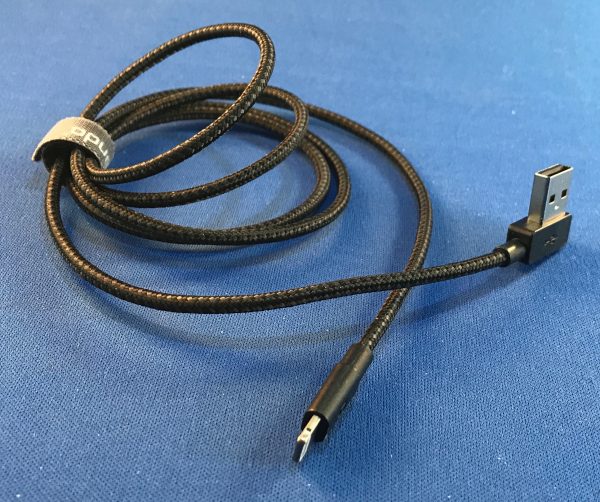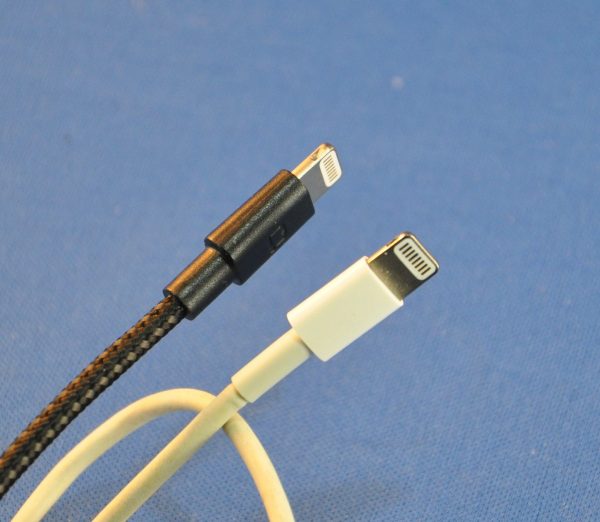Charging cables come with every new phone or tablet we buy. Here at the Gadgeteer, every time someone comes out with a new wrinkle in materials or configuration, however, we are asked if we want to review the third-party versions. When Nonda sent their ZUS USB-A to Lightning cable to us I jumped for it. There are a plethora of options and offerings out there, even if we limit them to just USB-A to Lightning cables. So, why would I particularly notice this one? It has a right-angle plug.
Note: Photos may be tapped or clicked for a larger image.
What is it?
The ZUS is a 4-foot (1.2 m) cable that has undergone the strenuous testing required to be approved in Apple’s MFI program. That means it can wear the label “Made for iPod/iPhone/iPad”. It has a heavy-duty layered construction in the wire and the connectors, making for a far superior product than the OEM versions. (The pictures in this article show a standard Apple cable in white and the ZUS cable in black for comparison. Note the thickness of materials in the connectors and the strain-relief collars.)
Hardware specs
- Apple MFi certification.
- Protected with Carbon Fiber.
- Lifetime Warranty.
What’s in the box?
Cable with Velcro tie-strap and warranty card
Design and features
The ZUS is a heavy gauge wire, wrapped in a carbon-fiber sheath. This, in turn, is wrapped in an EMI shield, and then in a PVC jacket. This is already one layer more than run-of-the-mill cables, but Nonda then encases the whole thing again in a braided nylon outer skin. At each end, they add heavy-duty stress relief collars and a steel body around the inner wiring of the connector. The wiring just beyond the strain relief collar has been tested to see how many times it can be bent back onto itself. Normal cables are tested to still operate optimally after 5000 bends. Nonda cables surpass this more than ten times this level, with 52,000 bends.
I weighed one of my Apple cables (3 ft/1 m) and found it was 18 grams. The Nonda cable (4 ft/1.2 m) is 27 grams. Even if you give Apple another 6 grams for the extra foot of cable, the Nonda weighs 2 full grams more, meaning there are denser materials – or at least, more of the materials that are there. While weight can’t be counted directly as part of the durability of the cable, my experience has led me to believe this to be true. Your mileage may vary.
What I Like
- High-Quality materials
- Strong anti-stress collars to prevent fraying at connectors
- Steel shell around connector core
- Over-engineered wire structure for longer performance
What needs to be improved
- I can’t think of anything
Final thoughts
I have bought dozens of cables, and have been given or had bundled with devices I have gotten probably double that. I used to buy the “cheaper than OEM but MFA-approved” versions, but lately, I have bought several cables similar to this Nonda cable for the same reason I like it: it is truly heavy-duty, and won’t fizzle out on me or damage my devices by developing a short. I’ve come to look at cables as an investment in my devices. If I charge it with a poor quality cable, there is a high likelihood that the power is going to be hampered in some way, and either take longer to charge, or somehow compromise the built-in safety mechanisms the device builders put in place. Or, at the time I need to depend on it, that cheap cable is going to burn out, and I’ll not be able to charge at all. In the immortal words of that internet meme: “Ain’t nobody got time for that!”
Price: $25.99
Where to buy: Nonda or Amazon
Source: The sample of this product was provided by Nonda.






Gadgeteer Comment Policy - Please read before commenting
I’ve used 90 degree and 180 degree Lightning cables before. They all work really well reducing the strain on the connector especially if you’re using it in the car. A bonus is that you can’t pull the wire to disconnect the cable as most people do – death to any electronics cable. The 90 degree connector forces you to pull it by the connector itself.
Although it’s a bit pricy (there are plenty of other cheaper options to choose from) everyone should have one of these cables in their kit.
What the review doesn’t discuss is whether this is a good data cable. Since it only mentions charging, it left me wondering. I own too many cables that work only for charging or make unreliable data connections.
I cannot remember the last time I did any significant data transfer using a cable. 2016, maybe? Since my backup for my iOS devices are greater than the free space on my Mac’s SSD, I can’t really test this. Sorry.
An overpriced piece of crap! After a couple of months, the so called indestructible cable is barely usable, with interruptions . It was used at my home, putting my phone in to charger in the evening and taking it out in the morning. Definitely not worth the money, and definitely not better than any other, better/ lower priced aftermarket cable! Don’t waste your money!